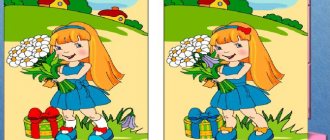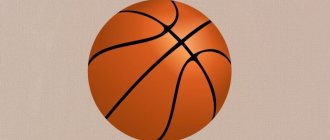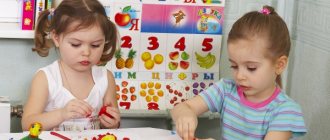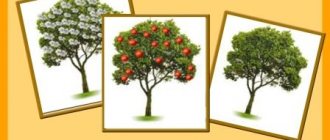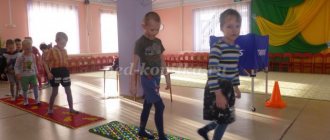Item properties
Summary of direct educational activities on the formation of elementary mathematical concepts in children of senior preschool age
Educational objectives
: consolidate children’s knowledge about geometric shapes, the ability to recognize and name them; to form children’s mathematical ideas about the properties of an object (color, shape, size), to teach them to identify one or more properties of objects and compare them with each other, to find general similarities and differences between a group of objects; develop the ability to understand and answer the question: “What is the shape/color/size?”; get acquainted with conventional signs.
Developmental tasks
: develop imaginative thinking, creative imagination, curiosity, ingenuity, attention; develop mental activity; develop and clarify children’s speech, the ability to express and justify their judgments, the ability to reason and draw conclusions.
Educational tasks
: cultivate the ability to work in a team, provide mutual assistance, thank for assistance provided; cultivate patience and respect for each other.
Materials and equipment
: interactive board with tasks, individual tablets according to the number of children, video film “Properties of an Object”, riddles, colored pencils, balls (different in size and color), “mini chests”, “wonderful bag”, handouts (trays with geometric shapes according to the number of children).
Progress of activity
Teacher
: Guys, stand in a circle. How many of us do you think are here today?
Children
: A lot of.
Teacher
: Right, but how do you find out exactly how many guys there are? What need to do?
Children
: We have to count.
Teacher
: Let’s count together, repeat after me (
The game “How many of us?” is being played
) One, two, three, four, five We start playing.
How many of us are there? - Let's count. ( Children count together with the teacher, pointing to each child
.)
Teacher
: Well done!
Everyone has been counted, now sit down on the chairs. ( The teacher draws the children’s attention to the pencils lying on the table
.) Guys, my funny pencil told an amazing story.
It turns out that all pencils can talk and even brag! ( The teacher picks up a red pencil and shows it to the children.
) This pencil, what color?
Children
: Red.
Teacher
: Right.
The red pencil told me: “I can be fire, poppy and even a flag.” ( The teacher sketches the named objects on the board
.) What can the rest of the pencils boast of?
What does an orange pencil, for example, tell you about yourself? ( Children, if desired, go to the board, tell a story and make a sketch. Similar work is done with blue, green and yellow pencils
.) The cheerful pencils whispered one word in my ear, guess what?
( The teacher pronounces the text of the riddle
.)
Through the fields, through the meadows, an elegant arc rose. ( This is a rainbow.
)
Who knows what colors a rainbow is made of? Name it. ( If desired, one child completes the task “Make a Rainbow” on the interactive board. The rest of the children use “Mini Caskets” to make a rainbow from colored squares
.)
Teacher
: Well done, you all turned out a beautiful multi-colored rainbow. Guys, look what's on my table? (The teacher shows the children the balls.)
Children
: Balls.
Teacher
: Guys, what do you think they have in common?
Children
: They are called by the same word “ball” and have the same shape.
Teacher
: What are the balls' shape?
Children
: Round.
Teacher
: Well done! How do they differ from each other?
Children
: Balls vary in size and color. They can be small or large. Balls are made from different materials. There are soccer balls, volleyballs, tennis balls. And sometimes it’s just a toy ball.
Teacher
: Right.
We can conclude that each item has its own properties: color, shape, size, and the material from which they are made. Guys, now let's watch the video of the movie “Properties of an Object.” ( After watching the film, children complete the task on the interactive board “Find the Common Thing
.”)
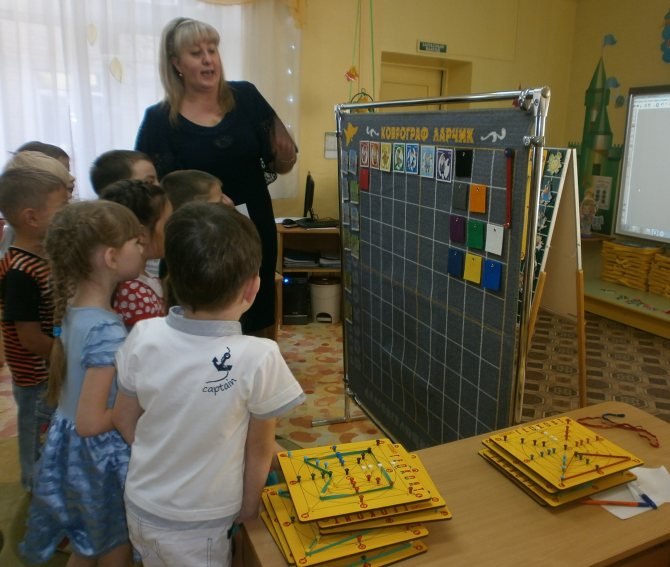
Teacher
: Guys, look, there are different objects on my table.
Let's take them for a ride along the magic path. ( The game “Magic Path of Analyzers” is played. Children try to notice and name as many properties of each object as possible. For example: a ball - red, round, rubber, and so on
.)
Teacher
: It's time to go visit. And to whom, you will find out if you guess the riddles: I tried to draw it, But, I see, I tried in vain, After all, without a compass, friends, You can’t draw it. What is this?
Children
: It's a circle.
Teacher
: Well done! Listen to the second riddle: Three peaks, Three corners, Three sides - Who am I?
Children
: This is a triangle.
Teacher
: Right. But I have another riddle: He has known me for a long time, Every angle in him is straight, All four sides are the same length.
Children
: It's a square.
Teacher
: Great! And the last riddle: We stretched the square and presented it to the eye, Who did it look like or something very similar? Can you guess what figure this is?
Children
: This is a rectangle.
Teacher
: Well done, you guessed everything!
Let's go to the "Kingdom of Geometric Shapes". I have a beautiful bag with geometric shapes in it. Let's play. ( The game “Magic Bag” is played. Each child draws a geometric figure from the bag, names it, gives a brief description.
)
Guys, now find objects in your office that are similar to these figures, name them. What are they? ( For example, this is a table. The table is like a square. It is square.
)
Teacher
: Guys, sit down on the chairs. Look what's on your tables?
Children
: Geometric figures.
Teacher
: Let's play.
And the game is called “Collect the beads.” ( Children need to lay out the figures one after another so that each subsequent figure differs from the previous one in one way
.) You have made beautiful beads!
Guys, you are great! We have an interesting game. Did you like it? ( Children in a circle speak in one sentence, choosing the beginning of a phrase from the reflective screen: today I learned..., it was interesting..., it was difficult..., I completed tasks..., I realized that..., now I can..., I learned..., from me it turned out..., I was surprised...
)
Irina Babkina, teacher,
MB preschool educational institution “TsRR D/s No. 99”, Chita, Trans-Baikal Territory
MAGAZINE Preschooler.RF
Topic: “Properties of objects.” Program content. 1. Form ideas about the signs of similarity and difference between objects. 2. Combine objects into groups - (based on similar characteristics) and select from the group individual objects that differ in some characteristic. 3. Develop children's connected speech. 4. Teach children to give reasons for their statements. 5. Continue teaching children to solve riddles. 6. Develop the ability to anticipate danger. Materials for the lesson: Demonstration - a picture of a bunny; Lotto pictures depicting fruits, flowers, vegetables; model of a basket of masks-hats of bunnies (for all) and foxes (one). Handout - cubes: five red and one yellow; bags or boxes for cubes. Contents of GCD. Organizing time. Mathematical warm-up. 1. Counting forward and backward 1 – 5. 2. Consolidating knowledge of numbers 1 – 5. I. Identifying signs of similarities and differences between objects. 1. Game: “Let’s Harvest.” —Who knows what time of year it is? (Autumn.) - What work is done in the garden and vegetable garden in the fall? (Vegetables and fruits are harvested in autumn). On the flannelgraph there is a model of a basket and pictures depicting flowers, fruits, and vegetables; picture with the image of a Bunny. — Our Bunny also decided to harvest from his garden. What did he put in his basket? Children, if desired, go to the flannelgraph and put pictures of vegetables in the basket. As the action progresses, you can ask questions: “What color are carrots? What shape is a cucumber? What size are radishes? What grows on earth? What grows underground? What grows above the ground? - Why didn’t you put chamomile? It can also grow in the garden, right? (Chamomile is a flower, and Bunny was collecting vegetables.). - Why is there an apple left? (An apple is a fruit, not a vegetable.) - What objects did you choose and on what basis? Because they're juicy? Large? Delicious? Are they used for food? (No. All these are vegetables, they grow in the garden.) 2) Game: “Magic bag”. On the tables the children have five red and one yellow cubes, and each a “magic bag” (a bag or box for the cubes). - What's on your tables? (Cubes.) - How are they similar and how are they different? (Same shape, size, all plastic. Different in color.) - What property distinguishes them from each other? (Color.) - Place cubes with the same properties in your “magic bag”. What cubes did you put in? What cubes are left? Why? (We put 5 red cubes - they have the same color, shape, size, material. There is a yellow cube left - it does not match the color). II. Physical education Stop, little bunny, don’t run along the narrow path. You’d better take care of your short little tail. The fox sneaks along the path. It’s unlikely he’s looking for mushrooms! One child depicts a sneaking fox, and the rest - running bunnies. The bunnies freeze, and then run away from the fox to their “house” places. III. Combining objects into groups according to a common property and separating from the group individual objects that differ in some property. - Guys, you have learned to find signs of similarity and difference among different objects. Let’s continue our journey with our Bunny: “let’s go” to the forest. I’ll tell you a few riddles and I think you’ll immediately guess what they’re about. Under the bushes, under the leaves We hid in the grass. Look for us in the forest yourself. We will not shout to you: “Ay!” (Mushrooms, berries.) - Name the berries shown in the first picture. (Raspberry, rowan, strawberry.) - What other berries do you know? Which of them grow in the forest, in the garden? Which ones grow only in the forest? (Blueberries, lingonberries, blueberries, cloudberries, etc.) - Who will be born wearing a hat? (Mushrooms.) - Name the mushrooms drawn in the picture. (White, honey mushrooms, fly agaric) - What do they have in common? (Each mushroom has a hat and a leg. They all grow in the forest.) - Which mushroom is the odd one out here and why? (Honey mushrooms always grow together, but fly agaric and white mushroom can grow alone; fly agaric is a poisonous mushroom, inedible, and the rest are edible). - Yes, indeed, there is even a poem about the fly agaric: It stands on the path On a thin leg, Covered with a colorful cap, Inedible, poisonous. - How many of you know why fly agaric is useful and for whom? (Amanitas can be eaten by moose. In folk medicine, fly agaric is used as a medicine - to prepare a rub). VI. Summary of the lesson. — The little hare was very glad to meet you. He really liked the stories of Sasha, Tanya, etc. about what grows and who lives in the forest. He is also happy about your gifts. Did you enjoy the trip with the Bunny?| Next > |
Item groups
A group of items is items that have one or more identical properties.
For example, on the table there are: apple, pear, plum, apricot. They vary in shape and color, but they are all sweet and grow on trees - they are fruits. You can find another group in the refrigerator: tomatoes, cucumbers, onions, potatoes - these are vegetables. Animals, birds, flowers, insects - these are all separate groups that have similar properties.
For example, your toys are a group of your things that you play with. Toys can be divided into subgroups: soft toys (all toys are soft), dolls (have a human appearance), cars (all have wheels), construction sets (consists of small parts from which something can be assembled) and so on.
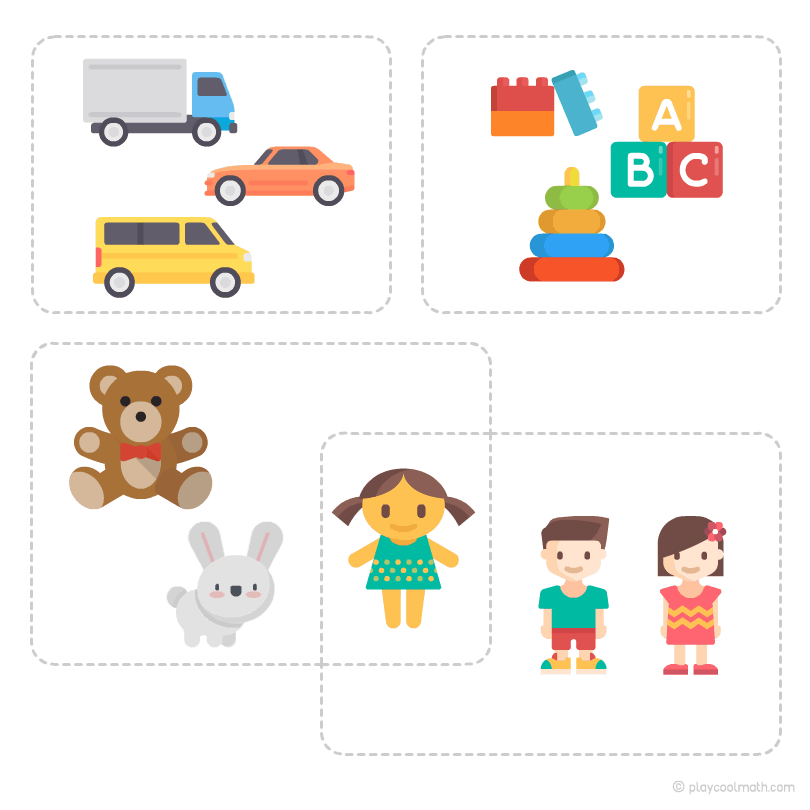
Now try it yourself. Find a common property for groups: birds , fish , pets
- Birds have wings and a beak. Almost all birds fly;
- Pisces - all fish live in water and can swim;
- Pets are all domesticated animals that live near a person and are cared for by him.
We got acquainted with objects, a group of objects and their properties. Next we will learn to compare them. Find out what they have in common and how they differ. What is more or less. What is higher or lower. And this is exactly what real mathematics is. Be sure to practice and take all the tests for this lesson.
Items and their characteristics
What is an object?
An object is a tangible thing (it can be touched), which can be viewed individually and which can have one or more properties: size , shape , color , mass , material , density , and so on.
Consider what is around you now. What do you think fits the description of the item? If you are reading this lecture, then next to you there is either a telephone, a computer or a laptop. Do you think we can call this an item? Of course you can - all these things fall under the description of the item. You can feel them, they have shape, they have mass. If an object fell and broke into small parts, then it is difficult to call it the object to which it belonged, it is difficult to consider it as a separate object, since it is no longer such. A broken vase is not a vase, but small pieces of glass.
The most important thing in defining an object is its properties, characteristics and characteristics. Let's take an example with objects such as pencils. Let's determine what properties a pencil has. Pencils differ from each other in color. If the pencils are new, then they are all the same size, and if they are not new, then you may notice that one pencil is shorter than the other in length. The second characteristic by which we can distinguish pencils is length. All properties of objects that can be counted and compared quantitatively can be called mathematical properties. Of the two properties of a pencil, only one is related to mathematics - size, because it can be counted and compared. For this we need a ruler. By knowing the length of each pencil, you can find out which is the largest and smallest. This can be done without a ruler if you lay out the pencils side by side and visually compare them - you will immediately see the largest and the smallest. Look at the picture and determine which is the smallest and which is the largest of the pencils.
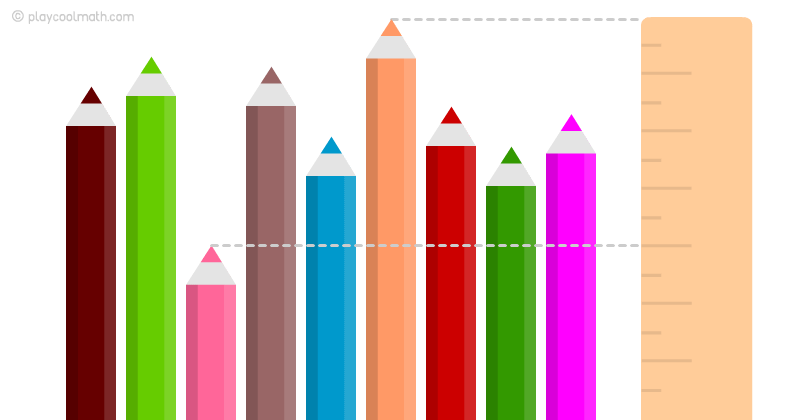
Try to independently determine the properties of such objects as: a fork, a book, Lego blocks, and which of the properties can be called mathematical and why?
Fork
- Material (there are iron, plastic, wood);
- Number of teeth (sometimes 2, 3, 4 teeth, and so on);
- Size and function (can be dining room, dessert room, tea room, etc.)
Mathematical properties: number of teeth , size
Book
- Size (can be large or small);
- Number of pages (can be thin, thick);
- Genre (there are different genres: stories, plays, novels, and so on);
- Binding (can be hard or soft).
Mathematical properties: Size and number of pages
Lego Blocks
- Form;
- Number of connecting points at the top;
- Color.
Mathematical properties: Number of connecting points at top
